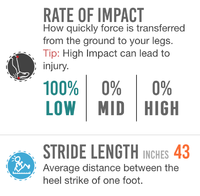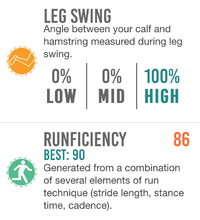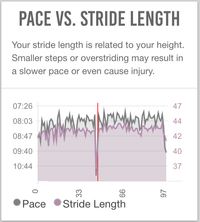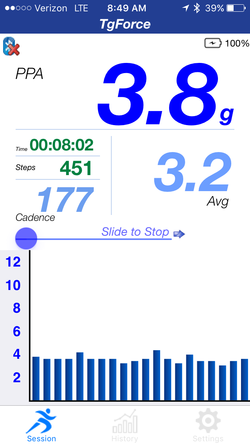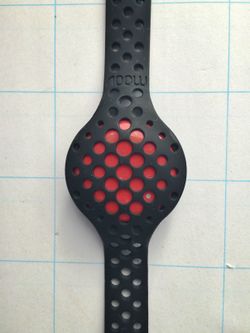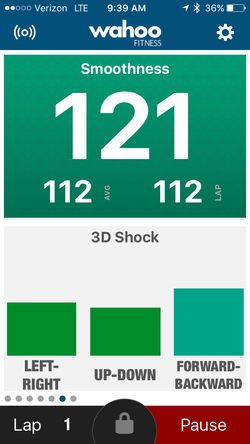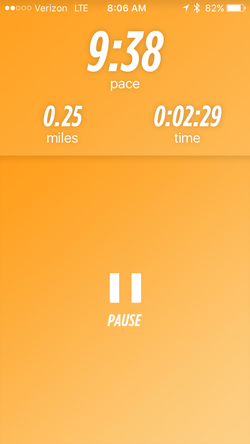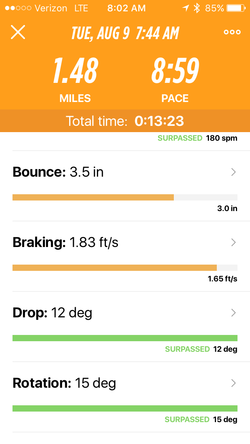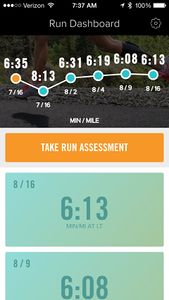Difference between revisions of "Running Sensors"
User:Fellrnr (User talk:Fellrnr | contribs) |
User:Fellrnr (User talk:Fellrnr | contribs) |
||
| Line 5: | Line 5: | ||
* [[Wahoo TICKR Run]] give some useful metrics, but you have to use their Smartphone App to get them. Their "3D Smoothness" would be awesome if it worked. | * [[Wahoo TICKR Run]] give some useful metrics, but you have to use their Smartphone App to get them. Their "3D Smoothness" would be awesome if it worked. | ||
* [[Moxy]] can provide a new way of evaluating exercise intensity by looking at the oxygen saturation of the blood within the working muscles. However, not only is it expensive, but you'll also need to dedicate significant time and effort into getting the best out of it. | * [[Moxy]] can provide a new way of evaluating exercise intensity by looking at the oxygen saturation of the blood within the working muscles. However, not only is it expensive, but you'll also need to dedicate significant time and effort into getting the best out of it. | ||
| − | * [[TgForce]] is a "one trick pony", but it's a great trick. It measures the | + | * [[TgForce]] is a "one trick pony", but it's a great trick. It measures the [[Impact]] on the lower leg rather than the foot, providing great real time metrics. Sadly there are production issues at the moment that are causing the sensors to fail. |
| − | * [[Moov Now]] This is a cheap and interesting sensor. Like the TgForce it can measure lower leg | + | * [[Moov Now]] This is a cheap and interesting sensor. Like the TgForce it can measure lower leg [[Impact]], but it's got software problems that have not been fixed. |
* [[Lumo Run]] Needs more development before it's ready for prime time. | * [[Lumo Run]] Needs more development before it's ready for prime time. | ||
{{:Running Sensors-table}} | {{:Running Sensors-table}} | ||
| Line 13: | Line 13: | ||
Many newer Garmin watches ([[Garmin 620| 620]], [[Garmin 920XT| 920XT]], [[Garmin Epix| Epix]], [[Garmin Fenix 3| Fenix 3]], etc.) combined with a special chest strap will provide extra metrics that can give insight into your Running Form. The Garmin watches will provide these metrics in real time, allowing you to see the effect of changes in your form. These metrics include: | Many newer Garmin watches ([[Garmin 620| 620]], [[Garmin 920XT| 920XT]], [[Garmin Epix| Epix]], [[Garmin Fenix 3| Fenix 3]], etc.) combined with a special chest strap will provide extra metrics that can give insight into your Running Form. The Garmin watches will provide these metrics in real time, allowing you to see the effect of changes in your form. These metrics include: | ||
| − | * Vertical Oscillation. This is how much the torso moves up and down with each stride. It is generally believed that less Vertical Oscillation is a better, but I suspect that this is an oversimplification. It's sometimes a thought that a greater vertical oscillation will result in greater | + | * Vertical Oscillation. This is how much the torso moves up and down with each stride. It is generally believed that less Vertical Oscillation is a better, but I suspect that this is an oversimplification. It's sometimes a thought that a greater vertical oscillation will result in greater [[Impact]], but this is not the case. [[Impact]] is how quickly you decelerate, so landing hard can result in less vertical movement but a shorter, more intense deceleration. It's even suggested that greater vertical oscillation will result in more braking force, but that does not seem reasonable. I believe that some are part of a runners vertical movement is likely to be elastic in nature (consider a bouncing rubber ball), some of the vertical motion will be while the runner is airborne (ballistic), and some of the vertical motion is the vertical deceleration as the runner lands. So it seems likely to me that excessive vertical oscillation is bad, but it's a tricky to know what excessive is likely to be, or how to correct it. |
* Ground Contact Time (GCT). [[The Science of Running Economy]] generally shows that longer Ground Contact Time is correlated with poorer [[Running Economy]]. | * Ground Contact Time (GCT). [[The Science of Running Economy]] generally shows that longer Ground Contact Time is correlated with poorer [[Running Economy]]. | ||
* Ground Contact Time Balance. This is the relative Ground Contact Time ratio of the left and right feet, which will reveal potential imbalances in the body. | * Ground Contact Time Balance. This is the relative Ground Contact Time ratio of the left and right feet, which will reveal potential imbalances in the body. | ||
| Line 21: | Line 21: | ||
''Main Article: [[RunScribe]]'' | ''Main Article: [[RunScribe]]'' | ||
| − | [[RunScribe]] is a small pair of [[Footpod]]'s that provide a wide variety of [[Foot Strike]] metrics. These include things like Impact G's, GCT, Braking G's, [[Pronation]], and more. I love the detailed metrics that are provided, and the insight into my running form, and possible imbalances. The main disadvantage with the RunScribe approach is that the data is not available during the run, and has to be analyzed afterward. RunScribe is rather more sophisticated than most Footpods as it not only has a 3-axis accelerometer, it also has a 3-axis gyroscope and a 3-axis magnetometer allowing it to sense far more movement. You can read about my testing at [[RunScribe]]. | + | [[RunScribe]] is a small pair of [[Footpod]]'s that provide a wide variety of [[Foot Strike]] metrics. These include things like [[Impact]] G's, GCT, Braking G's, [[Pronation]], and more. I love the detailed metrics that are provided, and the insight into my running form, and possible imbalances. The main disadvantage with the RunScribe approach is that the data is not available during the run, and has to be analyzed afterward. RunScribe is rather more sophisticated than most Footpods as it not only has a 3-axis accelerometer, it also has a 3-axis gyroscope and a 3-axis magnetometer allowing it to sense far more movement. You can read about my testing at [[RunScribe]]. |
[[File:RunScribe.jpg|none|thumb|500px|An overview of the data from RunScribe]] | [[File:RunScribe.jpg|none|thumb|500px|An overview of the data from RunScribe]] | ||
=MilestonePod= | =MilestonePod= | ||
| Line 38: | Line 38: | ||
[[File:Moxy Test 20150823 0825.jpg|none|thumb|800px|Here data from a Moxy test, showing a clear decline in SmO<sub>2</sub>.]] | [[File:Moxy Test 20150823 0825.jpg|none|thumb|800px|Here data from a Moxy test, showing a clear decline in SmO<sub>2</sub>.]] | ||
=TgForce= | =TgForce= | ||
| − | The TgForce measures just one thing; the peak | + | The TgForce measures just one thing; the peak [[Impact]] on your lower leg. While this is a far cry from the broad array of data gathered by devices like [[RunScribe]], TgForce may add some particularly valuable insight. Measuring the [[Impact]] that the foot can be a little misleading as the movement of your ankle can absorb a significant portion of that shock, so knowing how much of the force is transmitted to your lower leg may give a much better insight into injuries. The [[Impact]] that your lower leg (tibia) receives will be transmitted into your knee, so reducing that stress might be quite helpful. The companion app only runs on iOS devices, not android, which will limit the appeal for some, and unless you buy two devices, it will only measure one leg at a time. Even if you get two devices, it doesn't appear that the app readily supports this approach, unlike [[RunScribe]] that does a lot to provide side to side comparisons. That said, I really like to have real-time feedback, something that TgForce provides, either visually for use on a treadmill, or audibly outside. I've ordered a TgForce and my initial testing shows that the data from TgForce might be quite valuable, but there is a quality control problem and I've had several sensors fail. They have a fix and I should have a fully working sensor soon. |
| − | [[File:TgForce1.png|none|thumb|250px|This is the real time display, showing the | + | [[File:TgForce1.png|none|thumb|250px|This is the real time display, showing the [[Impact]] of each step (from one leg) in the bar graph, plus the current and average [[Impact]]. There are also metrics such as total steps and [{Cadence]].]] |
=Moov Now= | =Moov Now= | ||
''Main Article: [[Moov Now]]'' | ''Main Article: [[Moov Now]]'' | ||
| − | Moov Now is the second generation of Moov activity monitors, and is a small ankle mounted pod. It supports various sports, including cycling, swimming, boxing, and general workout routines like crunches, plank, etc. The Moov Now will also act as a general purpose activity tracker, including sleep tracking. However, it's the running functionality that I'll focus on. The Moov Now uses ankle mounted accelerometers to give a number of metrics, including [[Cadence]], Impact (at the tibia), and "range of motion" which is how far your leg swings from the furthest forward to the furthest back. I don't see the range of motion as a particularly useful metric, as it gives no indication if you are Over striding or not. However, I like the idea of getting | + | Moov Now is the second generation of Moov activity monitors, and is a small ankle mounted pod. It supports various sports, including cycling, swimming, boxing, and general workout routines like crunches, plank, etc. The Moov Now will also act as a general purpose activity tracker, including sleep tracking. However, it's the running functionality that I'll focus on. The Moov Now uses ankle mounted accelerometers to give a number of metrics, including [[Cadence]], [[Impact]] (at the tibia), and "range of motion" which is how far your leg swings from the furthest forward to the furthest back. I don't see the range of motion as a particularly useful metric, as it gives no indication if you are Over striding or not. However, I like the idea of getting [[Impact]] metrics on the tibia (lower leg), as I suspect this is more relevant than the [[Impact]] measured at your foot. It seems to me that your foot could undergo massive deceleration as your forefoot touches down without necessarily generating a huge amount of stress on your ankle, and even less stress on your knee. Unlike most activity monitors, it uses a replaceable battery that should last months, which is really nice, especially if you're traveling. It's a shame the Moov Now needs to be linked to a smart phone to work, as it means taking your phone on the run. The Moov Now seems to be an interesting device given its price, especially if you are interested in the other sports that it supports. <jfs id="B01CX26IP8" noreferb="true"/>. |
{| class="wikitable" | {| class="wikitable" | ||
|- valign="top" | |- valign="top" | ||
| Line 57: | Line 57: | ||
''Main Article: [[Lumo Run]]'' | ''Main Article: [[Lumo Run]]'' | ||
| − | Like many other devices, [[Lumo Run]] uses accelerometers to measure body movement, but uniquely (so far) Lumo places the accelerometers at the small of your back. This allows Lumo to not only detect [[Cadence]] and Vertical Oscillation, but also breaking and pelvic movement. The measurement of braking force is rather different from [[RunScribe]], as Lumo measures how much your overall body slows up with each stride, rather than measuring the deceleration of your foot in touch down. I believe that both approaches are important, and give valuable insight into possible biomechanical problems. In addition, Lumo will measure how much your hips (pelvis) will drop from side to side, and how much it rotates (twists). Lumo is available Lumo Run is available for <jfs id="B01K22SOYE" noreferb="true"/>. I really wish that Lumo would measure | + | Like many other devices, [[Lumo Run]] uses accelerometers to measure body movement, but uniquely (so far) Lumo places the accelerometers at the small of your back. This allows Lumo to not only detect [[Cadence]] and Vertical Oscillation, but also breaking and pelvic movement. The measurement of braking force is rather different from [[RunScribe]], as Lumo measures how much your overall body slows up with each stride, rather than measuring the deceleration of your foot in touch down. I believe that both approaches are important, and give valuable insight into possible biomechanical problems. In addition, Lumo will measure how much your hips (pelvis) will drop from side to side, and how much it rotates (twists). Lumo is available Lumo Run is available for <jfs id="B01K22SOYE" noreferb="true"/>. I really wish that Lumo would measure [[Impact]], as it would be great to know how much of the foot strike [[Impact]] reaches the hips. |
{| class="wikitable" | {| class="wikitable" | ||
|- valign="top" | |- valign="top" | ||
| Line 76: | Line 76: | ||
Power meters have helped cyclists for a number of years, providing a valuable metric around how hard the cyclist is exercising. Stryd is attempting to provide a power meter for runners, which superficially sounds like a good idea. Certainly, there are many problems with using Heart Rate to determine training intensity, and measuring VO2 is only practical in a laboratory, so and a power meter could be a better option. However Stryd actually measures movement and then calculates power. The details are a little unclear, as their website does not explain their approach or a well, nor do they seem to be any validation studies that I could find. It seems that Stryd measures Vertical Oscillation, braking and side-to-side (lateral) movement to calculate power, though it also measures Heart Rate and Ground Contact Time. It's a chest strap system, and it seems a lot of the metrics are also gathered by Garmin's [[Running Dynamics]]. It seems likely that you could perform similar calculations using the Garmin system, but I find myself unconvinced by the approach. | Power meters have helped cyclists for a number of years, providing a valuable metric around how hard the cyclist is exercising. Stryd is attempting to provide a power meter for runners, which superficially sounds like a good idea. Certainly, there are many problems with using Heart Rate to determine training intensity, and measuring VO2 is only practical in a laboratory, so and a power meter could be a better option. However Stryd actually measures movement and then calculates power. The details are a little unclear, as their website does not explain their approach or a well, nor do they seem to be any validation studies that I could find. It seems that Stryd measures Vertical Oscillation, braking and side-to-side (lateral) movement to calculate power, though it also measures Heart Rate and Ground Contact Time. It's a chest strap system, and it seems a lot of the metrics are also gathered by Garmin's [[Running Dynamics]]. It seems likely that you could perform similar calculations using the Garmin system, but I find myself unconvinced by the approach. | ||
=RUNTEQ Zoi= | =RUNTEQ Zoi= | ||
| − | Zoi places sensors on both the foot and the torso. This allows it to gain a little more insight than other sensors as it knows about the movement of the foot and the torso independently. Eventually I expect to see a company produce a group of sensors placed on each foot, each knee, and the pelvis, which would give insight into the movement and | + | Zoi places sensors on both the foot and the torso. This allows it to gain a little more insight than other sensors as it knows about the movement of the foot and the torso independently. Eventually I expect to see a company produce a group of sensors placed on each foot, each knee, and the pelvis, which would give insight into the movement and [[Impact]] forces across most of the body. The Zoi only has one Footpod, so it doesn't give you detailed foot strike information in the way that [[RunScribe]] can, though you could see them adding that functionality in the future. The Zoi gives quite a few metrics, including [[Cadence]], Ground Contact Time, Vertical Oscillation, breaking (at the torso, not foot breaking), of [[Foot Strike]] type (fore, mid, heel), Foot [[Impact]], and some [[Pronation]] information. Zoi has a smartphone app that provides real time feedback and post-run analytics, but I've not seen any support for displaying metrics on a watch. Currently Zoi is on pre-order in Europe for 150 EUR. I'd like to test this system if I can get hold of one. The approach is similar to the SHFT system, though the SHFT uses a 9-axis sensor and it's not clear what the Zoi uses. |
=RPM<sup>2</sup>= | =RPM<sup>2</sup>= | ||
RPM<sup>2</sup> (Remote Performance Measurement/Monitoring) is a pair of insoles that fit into your normal running shoes. These insoles measure pressure and use accelerometers to measure movement (a little like Sensoria). The details are not entirely clear from the web site, but they claim to measure [[Cadence]], Ground Contact Time, [[Foot Strike]], and "acceleration power". The system also claims to measure running power, though I'm not sure of the methodology. The RPM<sup>2</sup> system measure pressure in four areas (Sensoria has three), giving a [[Pronation]] measurement. There are notes that RPM<sup>2</sup> insoles are not waterproof, which is rather disconcerting, and if you run in different shaped shoes the fitment is likely to be problematic. The sizing of the insoles needs to take into account the position of the ball of the foot to ensure the sensor is in the right place. The system supports both Ant+ and Bluetooth so there is both a phone app and some information that can be displayed on a watch (it's not clear if this is more than just power). The system can also be used as a power meter for cycling. | RPM<sup>2</sup> (Remote Performance Measurement/Monitoring) is a pair of insoles that fit into your normal running shoes. These insoles measure pressure and use accelerometers to measure movement (a little like Sensoria). The details are not entirely clear from the web site, but they claim to measure [[Cadence]], Ground Contact Time, [[Foot Strike]], and "acceleration power". The system also claims to measure running power, though I'm not sure of the methodology. The RPM<sup>2</sup> system measure pressure in four areas (Sensoria has three), giving a [[Pronation]] measurement. There are notes that RPM<sup>2</sup> insoles are not waterproof, which is rather disconcerting, and if you run in different shaped shoes the fitment is likely to be problematic. The sizing of the insoles needs to take into account the position of the ball of the foot to ensure the sensor is in the right place. The system supports both Ant+ and Bluetooth so there is both a phone app and some information that can be displayed on a watch (it's not clear if this is more than just power). The system can also be used as a power meter for cycling. | ||
=SHFT= | =SHFT= | ||
| − | The SHFT system uses two pods, one on the chest and one on the foot, rather like the Zoi. The SHFT system includes some unusual metrics such as toe off angle and body angle, as well as Cadence, GCT, Vertical Osculation, Impact, Braking, and Foot Strike. They also claim to measure power for running, something I'd need to see demonstrated in a lab to believe it's accurate and even then I'm not sure it's useful due to the impact of [[Running Economy]]. The system requires you to carry your phone, and it appears that your only feedback is via audio through the headphones which I generally find rather ineffective. It looks like there are some good post run analytics available via the app, but no sign of data export. The price of the two SHFT sensors is $300 which is a little high compared with other systems. | + | The SHFT system uses two pods, one on the chest and one on the foot, rather like the Zoi. The SHFT system includes some unusual metrics such as toe off angle and body angle, as well as Cadence, GCT, Vertical Osculation, [[Impact]], Braking, and Foot Strike. They also claim to measure power for running, something I'd need to see demonstrated in a lab to believe it's accurate and even then I'm not sure it's useful due to the impact of [[Running Economy]]. The system requires you to carry your phone, and it appears that your only feedback is via audio through the headphones which I generally find rather ineffective. It looks like there are some good post run analytics available via the app, but no sign of data export. The price of the two SHFT sensors is $300 which is a little high compared with other systems. |
=Proportional Audio Feedback = | =Proportional Audio Feedback = | ||
| − | Many running sensors will provide information on your biomechanics using an audio message. Typically, this is a spoken message such as "you're landing on your heel" or "your braking is 1.31 feet per second." I generally find these audio messages far more annoying than they are useful. The messages tend to occur too infrequently for me to get a sense of how any modifications in my form are changing the metric being measured. The spoken word means it's a little tricky to combine this with music or radio. A better approach is to have a simple signal like a beep when your metric is outside the desired level. For example, [[TgForce]] will beep when your | + | Many running sensors will provide information on your biomechanics using an audio message. Typically, this is a spoken message such as "you're landing on your heel" or "your braking is 1.31 feet per second." I generally find these audio messages far more annoying than they are useful. The messages tend to occur too infrequently for me to get a sense of how any modifications in my form are changing the metric being measured. The spoken word means it's a little tricky to combine this with music or radio. A better approach is to have a simple signal like a beep when your metric is outside the desired level. For example, [[TgForce]] will beep when your [[Impact]] is too high, and you can combine this simple audio signal with music for the spoken word from a in audiobook or the radio. I believe that a superior approach is to have a variable audio signal that indicates how well you're doing. So instead of having a simple threshold such as 7g you'd have a range such as 5-9g. Then, when your [[Impact]] is above the lower threshold you would get an audio signal, but the audio signal would vary in one or more of volume/pitch/duration depending on where you are in the range. So a 5g [[Impact]] would produce a quiet, short, deep beep, and 9G [[Impact]] would produce a loud, longer, high-pitched beep. This way you'd get quantitive feedback on how well you're doing against your chosen metric. |
Revision as of 17:47, 27 November 2016
There are a growing number of wearable devices that will analyze your biomechanics, mostly from small startup companies, though the bigger players are also contributing to the space. Many of these devices a making use of the cheap and accurate accelerometers that are now readily available, though there are some other approaches being used. Here are my sound bite summaries:
- Garmin's Running Dynamics is well worth having if you own a Garmin watch that support it, though I wouldn't buy a Garmin just for its support of Running Dynamics.
- RunScribe provides lots of detailed and useful information, but I consider it a 'running lab' rather than an everyday training tool.
- MilestonePod is amazingly cheap and provides a wealth of data. It's worth the cost just for its ability to track the miles you put on your shoe, but it adds in more data than most other systems that cost many times as much.
- Wahoo TICKR Run give some useful metrics, but you have to use their Smartphone App to get them. Their "3D Smoothness" would be awesome if it worked.
- Moxy can provide a new way of evaluating exercise intensity by looking at the oxygen saturation of the blood within the working muscles. However, not only is it expensive, but you'll also need to dedicate significant time and effort into getting the best out of it.
- TgForce is a "one trick pony", but it's a great trick. It measures the Impact on the lower leg rather than the foot, providing great real time metrics. Sadly there are production issues at the moment that are causing the sensors to fail.
- Moov Now This is a cheap and interesting sensor. Like the TgForce it can measure lower leg Impact, but it's got software problems that have not been fixed.
- Lumo Run Needs more development before it's ready for prime time.
| Device | Cost | Status | Location1 | Analysis2 | Realtime3 | Carry Phone4 | Export13 | Symmetry | Cadence | GCT | VO | Impact7 | Braking | Pronation | Foot Strike | Other | Technology14 |
|---|---|---|---|---|---|---|---|---|---|---|---|---|---|---|---|---|---|
| Stryd | $200 | Highly Recommended | Footpod | Web/Export | Watch & Phone | No | Yes | No | Yes | Yes | Yes15 | Distance, Pace, Power, Leg Spring | 9-axis | ||||
| Running Dynamics v2 | $100 | Highly Recommended | Chest | Web/App/Export | Watch | Detailed | Yes | Yes | Yes | Yes | 3-axis | ||||||
| Running Dynamics v1 | $100 | Highly Recommended | Chest | Web/App/Export | Watch | Detailed | Yes | Yes | Yes | 3-axis | |||||||
| RunScribe | $200 | Highly Recommended | Footpod | Web/App | No | Yes | Yes | Yes | Foot | Foot | Yes | Yes | 9-axis | ||||
| MilestonePod | $25 | Highly Recommended | Footpod | App | Summary | Kinda6 | Yes | Yes | Foot ROI8 | Yes | Leg Swing | 3-axis | |||||
| Moxy | $770 | Worth Considering | Calf | Export | Watch | Detailed | SmO2 | IR SmO2 | |||||||||
| TgForce | $145 | Worth Considering | Ankle | App/Export | Phone & RTAF | Yes | Detailed | Yes | Tibia11 | 3-axis | |||||||
| Moov Now | $60 | Worth Considering | Ankle | App | Phone | Yes | No | No | Yes | Tibia11 | Leg Swing | 3-axis | |||||
| Wahoo TICKR Run | $80 | Worth Considering | Chest | App/Export | Phone5 | Yes | Detailed | Yes | Yes | Yes | 3D Smoothness12 | 3-axis? | |||||
| SHFT | $300 | Worth Considering | Foot & Chest | App | Phone & Audio Coaching | Yes | Yes | No | Yes | Yes | Yes | Yes | Yes | Yes | Toe-off angle, Watts, Body Angle | 9-axis | |
| Lumo Run | $80 | Not Recommended | Waist | App | Phone & Audio Coaching | No | No | Yes | Yes | Yes | Body | 9-axis | |||||
| Sensoria | $200 | Avoid | Sock/Ankle | Web/App | Phone & Audio Coaching | Yes | No | Yes9 | Yes | Yes10 | Foot10 | Yes10 | Pressure + 3-axis | ||||
| BSX | $300 | Avoid | Calf | Web/App/Export | Phone & Watch | Yes | Detailed | SmO2 | |||||||||
| RUNTEQ Zoi | 150 EUR | Untested | Foot & Chest | ? | Phone | ? | No | Yes | Yes | Yes | Foot | Body | Yes | Yes | |||
| RPM2 | $500 | Untested | Insole | ? | Phone | Yes | Yes | Yes | Yes | ? | Yes | Yes | Pressure |
- Where does the sensor go?
- What are your options for analyzing the results?
- Can you see the data in real time? This makes a huge difference if you're trying to improve your biomechanics. "Watch" means you have real time information so on the watch which is one of the ideal approaches. "Phone" means you get real time data shown on the phone display, which if it's done right can show an awful lot of data. "Audio Coaching" means you get periodic audio messages which I find more annoying than useful. "RTAF" is Real Time Audio Feedback, which means that your hearing an indication that you're past a threshold. For example, the TgForce will be if your impact is higher than a given threshold, and it will be part of every footstep.
- Do you have to carry your phone with you? I hate carrying a cell phone when running, so this is a factor for me.
- Phone needed to get anything beyond HRM.
- You can use two pods and compare the data, but the system won't compare the results for you.
- Impact can be measured in various places, such as the foot impact, the lower leg (tibia), or the chest. The impact can be measured as peak acceleration (g's) or as rate of change of acceleration (AKA "Jerk").
- This is Rate of Impact, which is slightly different to simple impact g's (see review for a few more details).
- The $200 kit only comes with one sensor, so you'd need to by a second.
- The Sensoria measures a number of metrics, but it does so remarkably badly.
- This is a measure of the impact on the lower leg, which excludes the impact that the foot as absorbed.
- This is the rate of change of acceleration (AKA "Jerk") in three separate axis: up/down, side-to-side, and left/right.
- A sensor that doesn't allow for data export locks you into the vendor's tools.
- A 9-axis sensor can detect twisting motions through its gyroscope, in addition to the acceleration measurement of a 3-axis sensor.
- Measuring Vertical Oscillation from a footpod is a dubious proposition and the results seem unsurprisingly poor.
Contents
[hide]1 Garmin's Running Dynamics
Main Article: Running Dynamics
Many newer Garmin watches ( 620, 920XT, Epix, Fenix 3, etc.) combined with a special chest strap will provide extra metrics that can give insight into your Running Form. The Garmin watches will provide these metrics in real time, allowing you to see the effect of changes in your form. These metrics include:
- Vertical Oscillation. This is how much the torso moves up and down with each stride. It is generally believed that less Vertical Oscillation is a better, but I suspect that this is an oversimplification. It's sometimes a thought that a greater vertical oscillation will result in greater Impact, but this is not the case. Impact is how quickly you decelerate, so landing hard can result in less vertical movement but a shorter, more intense deceleration. It's even suggested that greater vertical oscillation will result in more braking force, but that does not seem reasonable. I believe that some are part of a runners vertical movement is likely to be elastic in nature (consider a bouncing rubber ball), some of the vertical motion will be while the runner is airborne (ballistic), and some of the vertical motion is the vertical deceleration as the runner lands. So it seems likely to me that excessive vertical oscillation is bad, but it's a tricky to know what excessive is likely to be, or how to correct it.
- Ground Contact Time (GCT). The Science of Running Economy generally shows that longer Ground Contact Time is correlated with poorer Running Economy.
- Ground Contact Time Balance. This is the relative Ground Contact Time ratio of the left and right feet, which will reveal potential imbalances in the body.
- Computed metrics. The Garmin watches will use the basic metrics to calculate things like stride length (based on cadence and pace), and Vertical Ratio (vertical oscillation to stride length ratio).
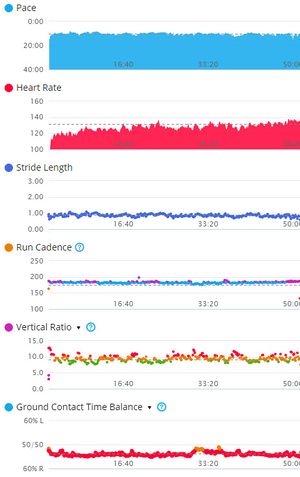
2 RunScribe
Main Article: RunScribe
RunScribe is a small pair of Footpod's that provide a wide variety of Foot Strike metrics. These include things like Impact G's, GCT, Braking G's, Pronation, and more. I love the detailed metrics that are provided, and the insight into my running form, and possible imbalances. The main disadvantage with the RunScribe approach is that the data is not available during the run, and has to be analyzed afterward. RunScribe is rather more sophisticated than most Footpods as it not only has a 3-axis accelerometer, it also has a 3-axis gyroscope and a 3-axis magnetometer allowing it to sense far more movement. You can read about my testing at RunScribe.
3 MilestonePod
Main Article: MilestonePod
MilestonePod is a vastly cheaper alternative to RunScribe, and while it doesn't provide the detailed analytics, it's a great value for money. It's also a cheap and effective way of keeping track of the mileage of your shoes, and is worth its price for that feature alone. Like RunScribe the MilestonePod doesn't provide real-time metrics, and you have to analyze the results post run. You can read about my testing at MilestonePod.
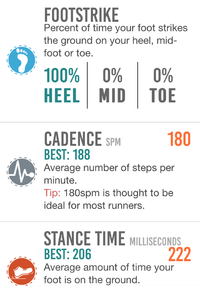 Foot Strike, Cadence and Stance Time (Ground Contact Time) |
4 Moxy
Moxy uses the same approach as BSX, using infrared light to detect the oxygen saturation of the muscles of blood. Moxy is not as easy to use as the BSX, but it's the data seems to be rather more reliable, though it requires rather more effort to interpret. I'll post a full review soon.
5 TgForce
The TgForce measures just one thing; the peak Impact on your lower leg. While this is a far cry from the broad array of data gathered by devices like RunScribe, TgForce may add some particularly valuable insight. Measuring the Impact that the foot can be a little misleading as the movement of your ankle can absorb a significant portion of that shock, so knowing how much of the force is transmitted to your lower leg may give a much better insight into injuries. The Impact that your lower leg (tibia) receives will be transmitted into your knee, so reducing that stress might be quite helpful. The companion app only runs on iOS devices, not android, which will limit the appeal for some, and unless you buy two devices, it will only measure one leg at a time. Even if you get two devices, it doesn't appear that the app readily supports this approach, unlike RunScribe that does a lot to provide side to side comparisons. That said, I really like to have real-time feedback, something that TgForce provides, either visually for use on a treadmill, or audibly outside. I've ordered a TgForce and my initial testing shows that the data from TgForce might be quite valuable, but there is a quality control problem and I've had several sensors fail. They have a fix and I should have a fully working sensor soon.
6 Moov Now
Main Article: Moov Now
Moov Now is the second generation of Moov activity monitors, and is a small ankle mounted pod. It supports various sports, including cycling, swimming, boxing, and general workout routines like crunches, plank, etc. The Moov Now will also act as a general purpose activity tracker, including sleep tracking. However, it's the running functionality that I'll focus on. The Moov Now uses ankle mounted accelerometers to give a number of metrics, including Cadence, Impact (at the tibia), and "range of motion" which is how far your leg swings from the furthest forward to the furthest back. I don't see the range of motion as a particularly useful metric, as it gives no indication if you are Over striding or not. However, I like the idea of getting Impact metrics on the tibia (lower leg), as I suspect this is more relevant than the Impact measured at your foot. It seems to me that your foot could undergo massive deceleration as your forefoot touches down without necessarily generating a huge amount of stress on your ankle, and even less stress on your knee. Unlike most activity monitors, it uses a replaceable battery that should last months, which is really nice, especially if you're traveling. It's a shame the Moov Now needs to be linked to a smart phone to work, as it means taking your phone on the run. The Moov Now seems to be an interesting device given its price, especially if you are interested in the other sports that it supports. Error: Could not parse data from Amazon!.
7 Wahoo TICKR Run
Main Article: Wahoo TICKR Run
The Wahoo TICKR Run is a chest strap based system that's similar to Garmin's Running Dynamics. It supports both Bluetooth and Ant+, which is nice, but most of the functionality beyond heart rate requires you to have your phone with you on your run. If you do, then you get Cadence, Ground Contact Time, Vertical osculation, and 3D smoothness. This 3D smoothness shows the jerk (rate of change of acceleration) in three planes; forward-backward, up-down, and side to side. This has great potential, but the smoothness depends far too much on the tightness of the strap, even varying with your breathing.
8 Lumo Body Tech Run
Main Article: Lumo Run
Like many other devices, Lumo Run uses accelerometers to measure body movement, but uniquely (so far) Lumo places the accelerometers at the small of your back. This allows Lumo to not only detect Cadence and Vertical Oscillation, but also breaking and pelvic movement. The measurement of braking force is rather different from RunScribe, as Lumo measures how much your overall body slows up with each stride, rather than measuring the deceleration of your foot in touch down. I believe that both approaches are important, and give valuable insight into possible biomechanical problems. In addition, Lumo will measure how much your hips (pelvis) will drop from side to side, and how much it rotates (twists). Lumo is available Lumo Run is available for Error: Could not parse data from Amazon!. I really wish that Lumo would measure Impact, as it would be great to know how much of the foot strike Impact reaches the hips.
9 Sensoria
Main Article: Sensoria
The Sensoria smart socks are made of materials that can detect pressure changes under your foot and transmit them back to anklet that communicates with a smart phone via Bluetooth. The Sensoria anklet also includes accelerometers to enhance the data gathered from the pressure sensors. While these socks are interesting, unlike a true pressure plate that has a matrix of pressure sensors, the socks have just three sensors, one in the heel and two in the forefoot. (Error: Could not parse data from Amazon! for a pair of left & right socks, plus one anklet.) Note that the socks last for 60 washes and cost $45, which works out to $0.75 per run. That might be cheap to a triathlete, but to most runners that works out pricy. Read my full review of Sensoria and the list of problems.
(Sensoria also make a tee that shirt includes an embedded Heart Rate monitor strap, you can plug a standard heart rate transmitter module into. They sell a dual Bluetooth/Ant+ transmitter, as well as working with the Polar H7 and some Garmin modules. )
10 BSX
Main Article: BSX
The BSX Lactate Threshold Monitor attempts to estimates your Lactate Threshold by measuring the oxygen saturation of the blood within your muscles. The results of the first version were extremely disappointing, but I have not had the opportunity to fully test the updated hardware. However, even if the BSX works perfectly, its value is limited by the relative ineffectiveness of Lactate Threshold Training. You can read about my testing at BSX.
11 Stryd
Power meters have helped cyclists for a number of years, providing a valuable metric around how hard the cyclist is exercising. Stryd is attempting to provide a power meter for runners, which superficially sounds like a good idea. Certainly, there are many problems with using Heart Rate to determine training intensity, and measuring VO2 is only practical in a laboratory, so and a power meter could be a better option. However Stryd actually measures movement and then calculates power. The details are a little unclear, as their website does not explain their approach or a well, nor do they seem to be any validation studies that I could find. It seems that Stryd measures Vertical Oscillation, braking and side-to-side (lateral) movement to calculate power, though it also measures Heart Rate and Ground Contact Time. It's a chest strap system, and it seems a lot of the metrics are also gathered by Garmin's Running Dynamics. It seems likely that you could perform similar calculations using the Garmin system, but I find myself unconvinced by the approach.
12 RUNTEQ Zoi
Zoi places sensors on both the foot and the torso. This allows it to gain a little more insight than other sensors as it knows about the movement of the foot and the torso independently. Eventually I expect to see a company produce a group of sensors placed on each foot, each knee, and the pelvis, which would give insight into the movement and Impact forces across most of the body. The Zoi only has one Footpod, so it doesn't give you detailed foot strike information in the way that RunScribe can, though you could see them adding that functionality in the future. The Zoi gives quite a few metrics, including Cadence, Ground Contact Time, Vertical Oscillation, breaking (at the torso, not foot breaking), of Foot Strike type (fore, mid, heel), Foot Impact, and some Pronation information. Zoi has a smartphone app that provides real time feedback and post-run analytics, but I've not seen any support for displaying metrics on a watch. Currently Zoi is on pre-order in Europe for 150 EUR. I'd like to test this system if I can get hold of one. The approach is similar to the SHFT system, though the SHFT uses a 9-axis sensor and it's not clear what the Zoi uses.
13 RPM2
RPM2 (Remote Performance Measurement/Monitoring) is a pair of insoles that fit into your normal running shoes. These insoles measure pressure and use accelerometers to measure movement (a little like Sensoria). The details are not entirely clear from the web site, but they claim to measure Cadence, Ground Contact Time, Foot Strike, and "acceleration power". The system also claims to measure running power, though I'm not sure of the methodology. The RPM2 system measure pressure in four areas (Sensoria has three), giving a Pronation measurement. There are notes that RPM2 insoles are not waterproof, which is rather disconcerting, and if you run in different shaped shoes the fitment is likely to be problematic. The sizing of the insoles needs to take into account the position of the ball of the foot to ensure the sensor is in the right place. The system supports both Ant+ and Bluetooth so there is both a phone app and some information that can be displayed on a watch (it's not clear if this is more than just power). The system can also be used as a power meter for cycling.
14 SHFT
The SHFT system uses two pods, one on the chest and one on the foot, rather like the Zoi. The SHFT system includes some unusual metrics such as toe off angle and body angle, as well as Cadence, GCT, Vertical Osculation, Impact, Braking, and Foot Strike. They also claim to measure power for running, something I'd need to see demonstrated in a lab to believe it's accurate and even then I'm not sure it's useful due to the impact of Running Economy. The system requires you to carry your phone, and it appears that your only feedback is via audio through the headphones which I generally find rather ineffective. It looks like there are some good post run analytics available via the app, but no sign of data export. The price of the two SHFT sensors is $300 which is a little high compared with other systems.
15 Proportional Audio Feedback
Many running sensors will provide information on your biomechanics using an audio message. Typically, this is a spoken message such as "you're landing on your heel" or "your braking is 1.31 feet per second." I generally find these audio messages far more annoying than they are useful. The messages tend to occur too infrequently for me to get a sense of how any modifications in my form are changing the metric being measured. The spoken word means it's a little tricky to combine this with music or radio. A better approach is to have a simple signal like a beep when your metric is outside the desired level. For example, TgForce will beep when your Impact is too high, and you can combine this simple audio signal with music for the spoken word from a in audiobook or the radio. I believe that a superior approach is to have a variable audio signal that indicates how well you're doing. So instead of having a simple threshold such as 7g you'd have a range such as 5-9g. Then, when your Impact is above the lower threshold you would get an audio signal, but the audio signal would vary in one or more of volume/pitch/duration depending on where you are in the range. So a 5g Impact would produce a quiet, short, deep beep, and 9G Impact would produce a loud, longer, high-pitched beep. This way you'd get quantitive feedback on how well you're doing against your chosen metric.

